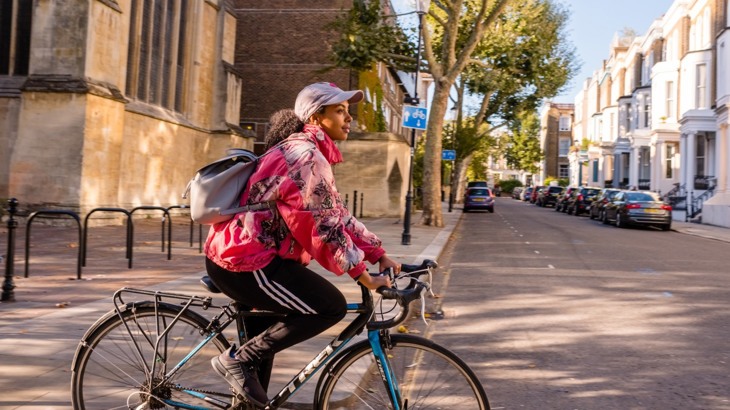Our London Head of Built Environment, Giulio Ferrini, delves into how we can take a proactive approach in shaping the evolving life after lockdown. He explains why now more than ever, we need to ensure the safety of those undertaking essential trips and exercising. So, where should we start?

The global challenge presented by the coronavirus pandemic has brought people, cities and countries together, in a global effort to limit the tragic impact of the virus.
Looking at the uncertain future ahead, we must take a proactive approach in shaping the evolving life after lockdown.
And ensure that it can lead to the fairer, healthier and happier world we want to see.
Designing for the unknown
As built environment professionals, the need to ensure the safety of those undertaking essential trips, and exercising has never been more pressing.
Under the current restrictions, this means changing our streets so that people can walk and cycle within social distancing guidelines.
Looking ahead, it’s natural to think about a return to normality, when people go back to their previous travel patterns.
However, we are in unchartered territory, and – as the lockdown loosens – new travel patterns and mode choices will emerge.
Without action, there is a real risk that the car will become the default mode of socially-distanced transport.
And non-car owners may have to choose between expensive private hire vehicles, crowded public transport or braving the newly-trafficked streets.
Shaping a new world for travel after the lockdown
Never before has it been so clear that the way we travel directly impacts the lives of those around us.
As activities gradually reopen, we cannot afford for transport choices to increase inequality and accelerate the climate emergency.
The pandemic has highlighted the crossovers between public health, economy, transport, education, air quality and social justice.
We need to work together
We must take a collective, proactive approach, using emergency measures to address the wider societal challenges, shaping a new world rather than expecting a return to the previous one.
With the reduction in motor vehicle levels, cities around the world are already implementing temporary changes to reallocate road space.
We have outlined some of the key considerations below to support others to do the same.
The change we need
To minimise travel, many have started living in their local neighbourhood, using local parks and shopping at the local high street.
Here, queuing systems have made it abundantly clear that our footways are insufficiently wide to allow social distancing.
We could:
- Widen footways in proximity to shops or on local high streets through traffic lane narrowing or parking suspension, using cones, planters or barriers.
- Introduce a longer pedestrian green phase at every signalised junction, and ensure it runs without pushing the button.
People, including key workers, are discovering cycling as a convenient way to undertake their essential journeys or to exercise.
Improving cycling and walking safety
To increase safety, we could:
- Install light segregation (wands, cones, armadillos, planters) along any existing painted bike lane, and connect any gaps in provision
- Roll out existing plans for segregated cycle routes (particularly to hospitals, parks and high streets) with light segregation.
- At junctions, local authorities could consider banning turns to remove hooking danger, or allowing people on cycles to share the longer all-green pedestrian phase, reducing road danger
- Enforce speed limits to reduce pressure on the NHS
- Implement pop-up cycle parking.
These emergency measures will become increasingly relevant as life after lockdown evolves and people look for socially-distanced ways to travel.
Transforming residential streets
On residential streets, we could:
- Ban pavement parking enabling socially-distanced walking on residential footways
- Create public space for exercise through temporary filters to reduce pressure on parks and greenspaces, prioritising areas of high deprivation, density and footfall, or low access to green space.
We could roll-out a trial of low traffic neighbourhoods, especially those that have already been developed.
This could ensure that, as lockdown loosens, streets do not suffer from increased traffic and streets remain pleasant for all.
From temporary to permanent
An integral part of the process, as for any project, is engaging the general public.
With the current restrictions in place, the opportunity for far-reaching community engagement and co-design is limited.
However, residents and local stakeholders can play a key role in shaping the project, through:
- Online tools to crowdsource crowded spots or locations for pop-up cycle lanes;
- Two-way conversations for the proposals via letter drops, FAQs, phone lines and social media, throughout the trial period
- On-site communication tools including banners and pop-up boards
As the restrictions change and the lockdown eases, further opportunities for appropriate engagement and co-design will emerge.
Evaluation is key
The potential insights to be gained from monitoring the evolving situation cannot be overlooked.
Most local authorities have calibrated and validated transport models, but the pandemic will redefine essential trips, travel patterns and mode choice.
Collecting data at the various stages of life after lockdown can be instrumental in re-setting goals, ambitions and targets.
We need to come together and take control
We cannot afford to not act, ignore this crisis and wait for life to return to normal.
This will likely exacerbate the complex societal issues we work to address.
It’s time to come together and take control, making sure our cities emerge safer, healthier and more resilient than before the pandemic.

